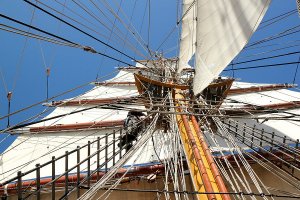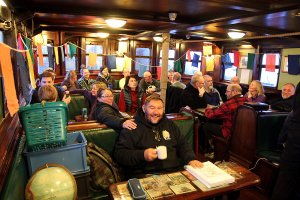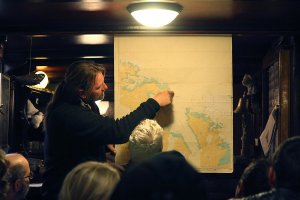Arto's Blog
| « The small quiet island called Tristan | Stop, sit down and look around » |
Sailing across the Atlantic
Posted: 2015-10-13 22:01:00, Categories: Travel, Sailing, 1273 words (permalink)
Upon leaving South Georgia, our captain set the course towards Cape
Town in South Africa, across the Atlantic Ocean. That meant about
three weeks of sailing day and night, with only one planned short
stop on the way: the small volcanic island Tristan da Cunha. For
Sandra and me, it was the first time to cross an ocean on a ship,
and to do it using wind power was even more amazing.
Well remembering our struggles with seasickness during the last two legs of sailing, we tried a different medicine (cinnarizine) of which Bark Europa luckily had small reserves on board. And it helped! During heavy seas we still felt somewhat uneasy, particularly in areas under the deck without windows, but it was a big improvement to our earlier situation. Now we could take part in our work shifts normally, attend all lectures and actually enjoy the sailing. :-) A special thanks to mate Elskarin, who supported us earlier during the difficult times and arranged us the medicine which helped.
During clear nights we enjoyed a superb view of the Milky Way and hundreds of other stars above us. In the middle of the ocean there weren't any settlements nearby causing light pollution, and Bark Europa mainly had lights on only inside. We had guided stargazing sessions organized by Eduardo, who as an astronomy teacher had extensive knowledge of the stars and was enthusiastic about his topic. We learned to recognize some of the brightest stars and well known constellations on the southern hemisphere, the difference of a planet and a star, and to read from the sky in which direction the South Pole is — the most basic form of navigation. Most of the nights were, however, not clear, more typical weather was cloudy with occasional rain. Winds are often the strongest just on the border between high and low pressure weather systems, and that's what a sailing ship needs to get forwards. With the help of modern satellite connections, the captain downloaded a weather forecast every day and tried to find the most favourable winds for us. During the leg from South Georgia until Tristan da Cunha, the sailing was supported with the engine a few times, the last leg from Tristan to Cape Town was done exclusively on sails. Our typical speed was between 5 and 8 knots, or between 9 and 17 kilometres per hour. During good winds we could sometimes maintain an average of over 10 knots for several hours, but that needed a wind which was not only strong but also stable enough. In stable conditions an optimal amount of sails could be set, whereas during a weather including gusts of considerably higher force than the base speed of the wind, more sails had to be taken down to avoid breaking them. Despite that a few sails did break, that belongs to the life on a sailing ship. Of course the ship had spares and all necessary tools on board to carry out repairs on the way. Each day, we were two times four hours on watch, which consisted of work shifts at the lookout, at the helm (steering the ship) and of helping to set, adjust and take down sails when needed. That gave an opportunity to learn not only in theory but also in practise how the sails and the ship behave in different wind conditions. The general idea of how each sail is controlled with ropes was easy to grasp, but remembering which rope goes where needed considerable time and effort. Many didn't learn all the ropes even by the end of the voyage, which cannot only be blamed on our laziness but also on the quite complex arrangement of the ropes on Bark Europa. Nevertheless, most people did learn the most commonly used ropes, and how to handle a rope when it was assigned to them, which was enough to give a hand when the action was coordinated by a member of the permanent crew. Another task in sail handling was furling, which means tying the sails against their wooden stays when taking them down (to avoid unused sails catching wind), and respectively unfurling when setting the sails again. To do that it was necessary to climb up the masts, even until the top, in all weather conditions. The permanent crew took care of it in hard weather, otherwise we, the voyage crew, were encouraged to participate too. Nobody was forced to climb, it was done on a voluntary basis, as much as each person felt comfortable with. We had climbing harnesses to secure ourselves to metal wires, but it was still quite an adrenaline rush to climb high up when it was windy. And climbing up was of course not of any use in itself, you had to use your hands for tying and untying ropes instead of just holding tight to the nearest structure. My respect to the brave guys and girls who did that in the middle of the night in heavy rain. In beautiful, sunny weather we of course also climbed up the masts just for fun, to enjoy the view and to take photos. The lecture programs continued with new topics, including sailing and navigation, weather observations, ocean currents and ecosystems, our solar system and the universe, and Jordi's favourite, large seaweeds called kelp. The voyage crew were also encouraged to share their knowledge, which resulted in talks about quite a variety of themes, including being shipwrecked (Adam), the Falkland War (James), United Nations refugee work (Helen) and working in a missile silo (Glen). Additionally we watched some documentaries and movies, read books, played card games and had a few special events such as painting Easter eggs and a series of friendly competitions called the Ship's Olympics. So the answer to perhaps the most common question presented to us, "Won't you get bored on such a long sailing trip" is "No, there wasn't any risk of it." Every evening after dinner everybody gathered to the deckhouse to the "Eight o'clockie" hosted by the captain. He reviewed the last 24 hours of sailing, pointed our position on the map and showed the weather forecast for the upcoming night and day. Our guides continued with announcements and other general information everybody should know. Those were almost the only times we were all together. After the official part the bar was open and the deckhouse was the place to socialize, but many also returned to their cabins to sleep or read, had work shifts or something else to do. In the middle of the ocean there weren't as many animals around as near the coastline. Still, a few times we saw whales or dolphins, and some birds such as albatrosses and petrels flew to their fishing trips hundreds of kilometres off the land. The temperatures went up considerably after we left the cold Antarctic waters, but mostly we still needed a long sleeve or a jacket (or both) when being outside. There were times when a t-shirt was sufficient, but sunbathing on the deck with just bikinis on, the sailing ship smoothly gliding forwards in tropical waters, didn't happen on this voyage. We didn't mind, we had joined for an experience and an adventure, not a luxury cruise in the Caribbean.No feedback yet

Copyright Arto Teräs <ajt@iki.fi>, licensed under the Creative Commons Attribution-Share Alike 3.0 Unported License. (Unless otherwise mentioned in individual photos or other content.)









